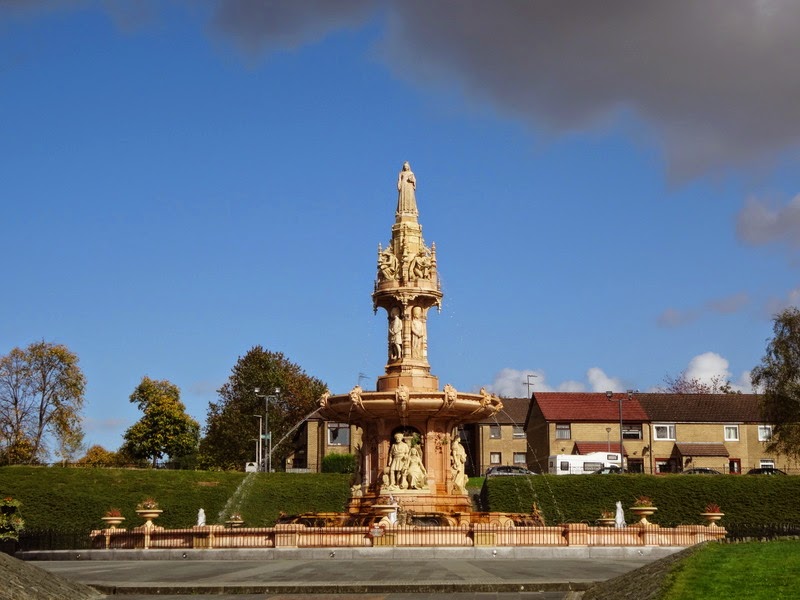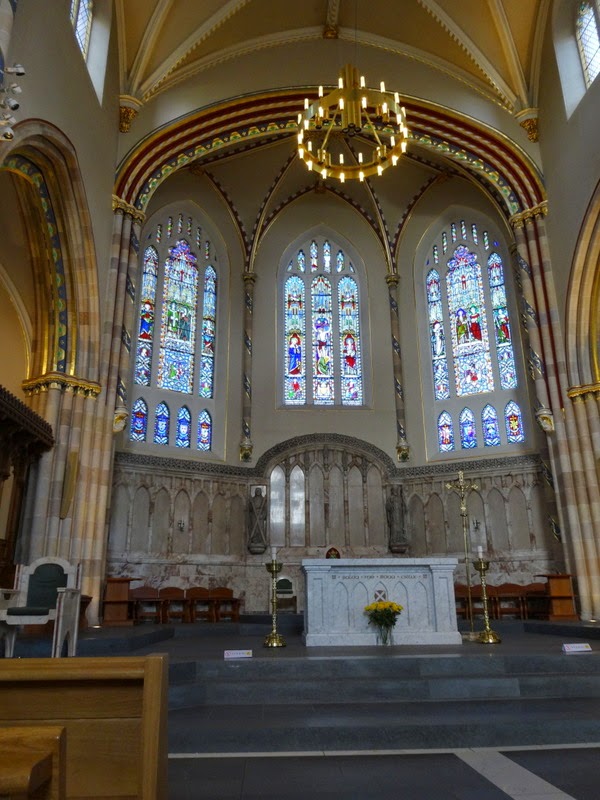After a delicious meal, Marty and I headed to the train station and bought 2 same day, reduced rate tickets for the journey into Glasgow. It took us about 45 minutes to arrive at Queen Street, which is probably less time than it would have taken to make the trip by car! Plus no parking hassles…..or crazy in-city driving either. Great planning on my part, for sure.
We headed out of the station and began our walk towards Glasgow Cathedral, which was several blocks away, and soon found ourselves trudging through the campus grounds of Glasgow University. Let me just say that it sure was a busy place!
After about 15 minutes, it was easy to spot the Cathedral in the distance.
If you are wondering just what makes this cathedral so significant, it is because it is the only medieval cathedral in Scotland to have survived the 1560 Reformation virtually complete.
The church was built in the 13th century, and devoted to St. Mungo who's remains are buried within the church. A stained glass window along the side walls of the cathedral, depicts the saint.
In the Sacristy a Coat of Arms adorns one of the walls
While Marty and I were exploring the many details of this Cathedral, there was a large group of French youngsters attempting to solve a treasure hunt of items within the church. Twice we were approached for assistance by a small group of girls asking us to help them with a clue. Their plea was in perfect English with a slight French accent, but when I attempted to answer, I was told that they spoke very little English and that they did not understand. I attempted hand signals which resulted in looks as if I had 3 heads. Oh well….at least I tried!
Adjacent to the cathedral is a museum devoted to St. Mungo and the many religions of Scotland. I was able to get this shot of the cathedral through the upstairs window.
The premise of the museum is to stress tolerance for all religions and it explores the importance of religion in peoples' lives across the world, and throughout time.
There were certainly some interesting artifacts contained inside, one of which was this mummy which dates from 500 B.C.
When I saw the smile, I was sure this was a reproduction, but not so. How amazing to have such an old artifact on display in this building.
Just across the street from the Cathedral stands the oldest building in Glasgow, having been built in 1471. At one time, bishops would have had residence in this building. The original floor beams are still intact, but new floor boards were placed over the old ones because they were certainly showing their age.
There was a lovely garden maze in the backyard, which is actually nestled between many buildings that would have popped up since this one. You could call it a secret garden, (from the outside) I suppose.
And here you can see the side of the building where it still stands today.
We headed down the street to make our way to the People's Palace. This is another preserved building that stands in a large Green Park along the Clyde River. On the way we passed this unusual clock tower. And you might note the beginning of a blue sky!
It wasn't difficult to spot the palace, as it is the only building that stands in the Green.
The museum is devoted to life in Scotland, most of which involved the 20th century. It addressed many of the social issues that Scotland has faced in its recent years.
There were these interesting flyers pertaining to safe alcohol consumption.
One assigned points to certain strength amounts.
And, the second explained how many points you could safely drink in a week.
Kind of like weight watchers for alcohol!
The Buttercup Dairy was one of the featured displays. Once just a typical dairy, the proprietor decided to try something new. Rather than have customers order from the counter, he placed items on shelves so that his patrons could choose what they might like, and bring it to the counter to purchase.
We know it as grocery shopping, but it was a whole new concept back in the day.
Attached to the back of the Palace is a huge winter garden, making it like Phipps Conservatory on the inside.
Just outside the Palace is this Terra Cotta fountain featuring Queen Victoria on the top.
It is the largest Terra Cotta fountain of its kind. Would you expect anything less?
Across the way there was this beautiful building. I was told that it used to be a rug manufacturer building. It has since been turned into office space and a micro brewery is inside.
Did someone say micro brewery?
Of course, Marty had to try out the St. Mungo!
By now, the rain was gone, and we were treated to blue skies. Walking through the park afforded us some beautiful sights.
Along the river Clyde stands the Catholic Cathedral devoted to St. Andrew, patron saint of Scotland.
This church was built in the 18th century. The interior is just stunning!
One of the stained glass windows above the altar features St. Patrick.
And I loved the Lady Chapel featuring Mary holding baby Jesus with angels floating around her.
I was able to catch the reflection of the church in the building next door.
We walked past the Central Train Station
And the Argyll Arcade, that reminded me of the old Jenkins Arcade in Pittsburgh.
And by now, it was pretty much time to call it a day.
But before I close, let me just tell you a wee bit about this city's patron saint, St. Mungo.
This symbol stems from the 19th century and is well known among Glaswegians.
The saint was associated with a bird, tree, bell, fish and a ring.
The bird was a pet which belonged to St. Serf, Mungo's master in Culross. Mungo restored it to life after his jealous classmates hoped to blame him for its death. (I'm not quite sure what kind of classmates this man had in the late 500's.)
The tree represents a camp fire at Kinross which St. Mungo relit using branches from other trees.
The fish and the ring symbolize the story of St. Mungo saving the honor of a queen whose husband suspected her of infidelity. Her ring had been lost, and St. Mungo asked for a fish to be caught which just so happened to have the ring inside, thus saving the queen's honor and her life.
(Personally, I think she should have considered getting a new husband. )
Finally, the bell represents a gift the Pope gave to St. Mungo after his many pilgrimages to Rome and in recognition of this good works.
The fish and the ring seem to be the most significant story as you can tell by these light posts that stood along the streets.
And, of course, anything involving fish makes Marty happy.
It's just too bad that we didn't find a t-shirt to commemorate the visit.
But, then again, maybe it isn't!






























No comments:
Post a Comment